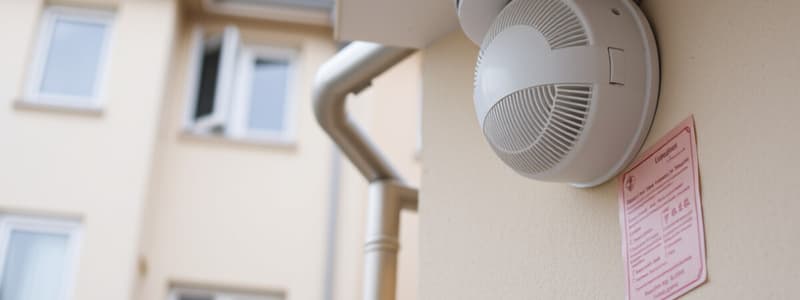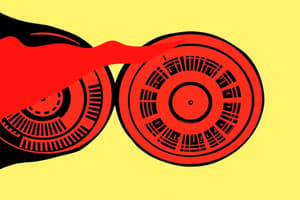Podcast
Questions and Answers
Which types of dwellings must be equipped with approved smoke detectors?
Which types of dwellings must be equipped with approved smoke detectors?
- All residential buildings
- One and two family dwellings not regulated by sections 26A or 26B (correct)
- Commercial buildings
- Only multi-family dwellings
Where must smoke detectors be installed in one and two family dwellings?
Where must smoke detectors be installed in one and two family dwellings?
- Only in the basement
- On each level of habitation and the basement level (correct)
- Only in the kitchen
- In every room
Who has the authority to allow the installation of approved monitored battery powered smoke detectors?
Who has the authority to allow the installation of approved monitored battery powered smoke detectors?
- The building owner
- The head of the fire department (correct)
- The local government
- The tenants
Where should smoke detectors be installed in relation to stairways in one and two family dwellings?
Where should smoke detectors be installed in relation to stairways in one and two family dwellings?
Where should smoke detectors be installed outside sleeping areas in one and two family dwellings?
Where should smoke detectors be installed outside sleeping areas in one and two family dwellings?
What type of buildings must have approved smoke detectors installed according to specific regulations?
What type of buildings must have approved smoke detectors installed according to specific regulations?
In buildings with three to five units, where must series of interconnected approved primary power smoke detectors be installed?
In buildings with three to five units, where must series of interconnected approved primary power smoke detectors be installed?
What does 'approved primary power' refer to for the purposes of smoke detector regulations?
What does 'approved primary power' refer to for the purposes of smoke detector regulations?
What happens if the primary power source for smoke detectors fails?
What happens if the primary power source for smoke detectors fails?
Which section specifically does not apply to Section 26E?
Which section specifically does not apply to Section 26E?
What is recommended to be installed on each level of habitation in one and two-family dwellings?
What is recommended to be installed on each level of habitation in one and two-family dwellings?
What is the primary function of approved smoke detectors in residential buildings?
What is the primary function of approved smoke detectors in residential buildings?
Who is responsible for enforcing the provisions of Section 26E?
Who is responsible for enforcing the provisions of Section 26E?
Which type of smoke detectors can be installed in one and two-family dwellings according to regulations?
Which type of smoke detectors can be installed in one and two-family dwellings according to regulations?
In buildings with three to five units, where should smoke detectors be installed outside of each unit?
In buildings with three to five units, where should smoke detectors be installed outside of each unit?
What does 'monitored' refer to in monitored battery-powered smoke detectors?
What does 'monitored' refer to in monitored battery-powered smoke detectors?
Flashcards are hidden until you start studying
Study Notes
Smoke Detectors in Residential Buildings
- Section 26E mandates approved smoke detectors in one and two family dwellings not governed by sections 26A or 26B.
- Smoke detectors must be installed on each level of habitation and the basement in these dwellings.
Installation and Locations
- Smoke detectors should be positioned at the top of each stairway leading to the next floor, near the base but not in the stairway.
- They must also be installed outside each separate sleeping area.
Buildings with Units
- Buildings with three to five units require interconnected approved smoke detectors in all common hallways and basement areas.
- Only approved monitored battery powered smoke detectors can be allowed at the discretion of the head of the fire department.
Power and Functionality
- 'Approved primary power' refers to smoke detectors powered by alternating current from an electric power company.
- If the primary power source fails, the smoke detectors switch to a permanently wired secondary power source.
Enforcement and Compliance
- The head of the fire department is responsible for enforcing the provisions of Section 26E.
- Sections 26A, 26B, and 26C apply to smoke detector provisions, while Section 30 does not.
Types of Detectors and Requirements
- In one and two family dwellings, battery-powered smoke detectors are permitted as long as they are approved and monitored.
- Smoke detectors are specifically required in residential buildings, with the exclusion of kitchens for their installation.
Overall Purpose
- The primary function of approved smoke detectors in residential settings is to detect smoke and alert occupants to potential fire hazards.
Studying That Suits You
Use AI to generate personalized quizzes and flashcards to suit your learning preferences.




